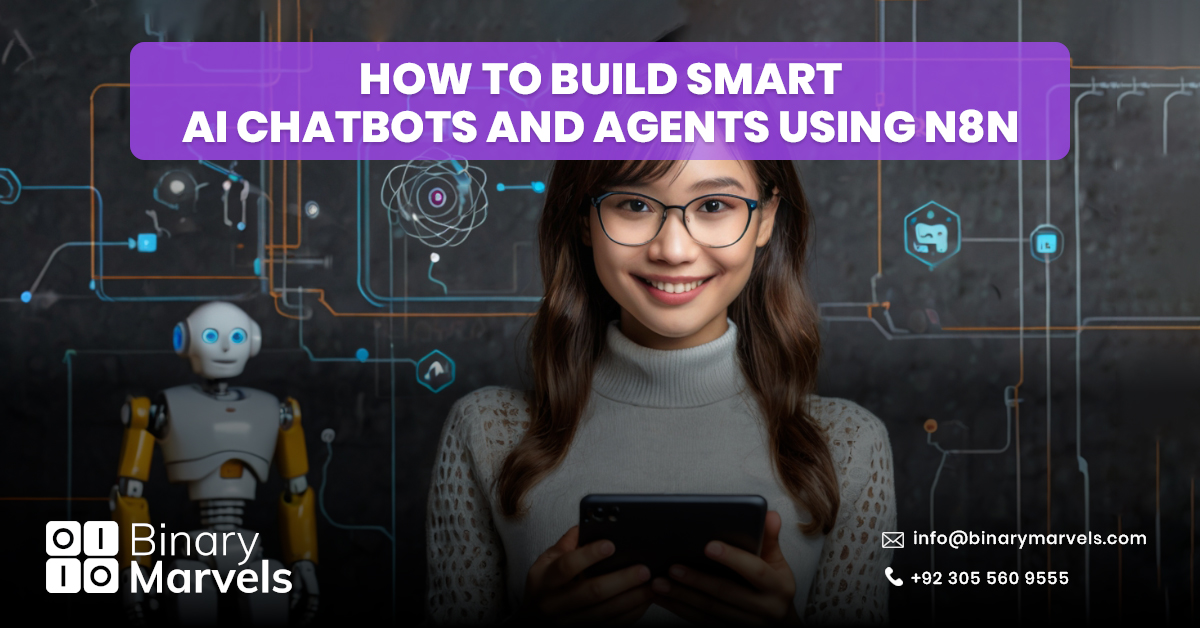
Want to build smart AI chatbots and agents without writing a single line of code?
With the rise of no-code automation tools, creating intelligent AI-driven experiences is easier than ever. n8n is a powerful workflow automation platform that lets you connect apps, APIs, and AI models like OpenAI to build highly capable chatbots and agents. Whether you’re a business owner, developer, or tech-savvy entrepreneur, you can use n8n to automate conversations, handle support requests, qualify leads, and much more.
In this guide, you’ll learn how to build smart AI chatbots and agents using n8n step by step. We’ll cover the core concepts, walk through real examples, and show you how to connect everything from message triggers to intelligent responses powered by large language models.
Let’s get started and turn your automation ideas into reality.
Also Read: Top 10 AI Companies in Pakistan
What Is n8n and Why It’s Ideal for AI Automation?
n8n is an open-source workflow automation tool that allows you to connect applications, APIs, and services using a visual, drag-and-drop interface. Unlike rigid automation platforms, n8n gives you full control over logic, data flow, and integrations, making it a powerful choice for building smart AI-powered solutions.
What sets n8n apart is its flexibility. You can create complex workflows using conditions, loops, and variables, all without writing code. For AI applications, this means you can easily connect tools like OpenAI, Claude, or Hugging Face to automate conversations, process data, and make intelligent decisions based on user input.
Whether you’re building a chatbot for customer service, an internal AI assistant, or a multi-step automation agent that interacts with APIs and databases, n8n offers the tools to make it happen. Its modular design and active community also ensure that new integrations and capabilities are always evolving.
What is an n8n Chatbot?
An n8n chatbot is an automated conversational workflow built using the n8n platform. It can receive messages from users, process those inputs through various nodes and logic, and return intelligent responses. These chatbots can be connected to platforms like Telegram, Slack, Discord, WhatsApp, or even embedded into custom applications.
The core of an n8n chatbot relies on triggers, such as a webhook or message event, followed by a sequence of actions like filtering input, calling an AI model, and sending a response. You can use OpenAI or other language models to make your chatbot smarter and more dynamic, responding in a natural, human-like manner.
n8n chatbots are ideal for automating customer support, answering FAQs, booking appointments, collecting data, or integrating with your internal tools. Since everything is visual and modular, you can build and improve your chatbot as your needs evolve—no coding required.
What Is an n8n AI Agent?
An n8n AI agent is an advanced workflow built using n8n that goes beyond simple chatbot responses. Unlike a basic chatbot that replies to single messages, an AI agent can remember context, make decisions, interact with multiple systems, and perform complex tasks without human intervention.
These agents use a combination of AI models, conditional logic, memory management, and external integrations to simulate intelligent behavior. For example, an AI agent can receive a customer query, analyze sentiment, fetch relevant data from a CRM, generate a tailored response using OpenAI, and log the interaction in a database—all in a single automated flow.
The key difference between a chatbot and an AI agent in n8n is autonomy. While chatbots often respond to direct prompts, AI agents can proactively perform tasks, hold multi-turn conversations, and adapt based on previous interactions. This makes them perfect for use cases like AI-powered virtual assistants, lead qualification bots, smart ticket routing systems, and more.
How to Build a Chatbot in n8n?
Creating a chatbot in n8n is a straightforward process that involves setting up triggers, integrating a chat platform, and adding AI logic. You don’t need any coding experience to get started. Here’s a step-by-step breakdown to help you build your first no-code AI chatbot using n8n.
Step 1: Define the Purpose of Your Chatbot
Start by deciding what your chatbot will do. Will it answer FAQs, collect user information, provide support, or handle another task? Having a clear goal helps you design an effective workflow.
Step 2: Set Up a Trigger Node
Use a trigger node like Webhook or one connected to a chat platform such as Telegram or Slack. This node will receive incoming messages from users and start the workflow.
Step 3: Add Message Parsing and Filters
Use nodes like Set, IF, or Switch to filter and process user input. This lets you handle different types of questions or commands and route the conversation accordingly.
Step 4: Connect to an AI Model
Add an HTTP Request node to connect with OpenAI or any other language model. Send the user’s message as input and receive a generated response. You can customize prompts and control the tone or format of replies.
Step 5: Send the Response Back to the User
Use another HTTP Request or integration node to send the AI-generated reply back through the original chat platform. This completes the loop and creates a dynamic user interaction.
Step 6: Test and Iterate
Run your workflow, test different inputs, and refine your logic. You can add error handling, logging, or even memory features to make your chatbot smarter over time.
With n8n, your chatbot can grow as your needs evolve. You can easily integrate new tools, add decision-making steps, and even transform your chatbot into a fully functional AI agent.
Also Read: Industries That Benefit Most from AI Chatbots in 2025
How to Build an AI Agent in n8n?
Building an AI agent in n8n involves creating a more intelligent and autonomous workflow that can handle tasks, make decisions, and remember past interactions. While similar to chatbot creation, AI agents require additional steps like context management, memory, and multi-step logic.
Step 1: Start with an Input Trigger
Choose how your agent will receive input. This could be through a Webhook, a scheduled event, or integration with platforms like Slack, Telegram, or a web form. The trigger starts the agent’s workflow.
Step 2: Capture and Store Context
Use the Set node to extract important information from the input. Then, store context like user ID, conversation history, or task type in a database or use tools like Redis or n8n’s built-in data storage.
Step 3: Integrate an AI Model
Use an HTTP Request node to connect with OpenAI, Claude, or another large language model. Pass the current user input along with stored context to generate a personalized, relevant response or decision.
Step 4: Add Conditional Logic and Decision-Making
Use IF and Switch nodes to evaluate conditions based on AI responses or user input. This allows the agent to choose different actions depending on the situation, such as escalating to support or updating a CRM.
Step 5: Perform Actions Automatically
Let your agent take real action. It can send emails, update databases, call APIs, post messages, or trigger other workflows based on its decisions. These steps define the “agent” behavior.
Step 6: Manage Multi-Turn Conversations
To support back-and-forth interaction, loop your workflow using stored session data. This allows your agent to handle follow-up questions and keep the conversation going intelligently.
Step 7: Monitor and Improve the Agent
Add logging to track how the agent performs. Analyze errors or low-confidence responses and improve the prompts, logic, or memory handling. You can also integrate feedback loops for continuous learning.
With these steps, you can turn n8n into a platform for building AI agents that act autonomously, make smart decisions, and handle complex workflows without manual input.
Best Practices for Smart Chatbots and AI Agents in n8n
To get the most out of your AI chatbot or agent in n8n, it’s important to follow best practices that ensure reliability, efficiency, and scalability. Here are some key tips to help you build smarter, more effective automation workflows.
Keep Workflows Modular and Organized
Break your workflows into smaller, reusable pieces. Use sub-workflows for repetitive tasks like logging, sending messages, or fetching user data. This makes it easier to manage and update your automations as they grow.
Use Clear and Structured Prompts for AI Models
When integrating tools like OpenAI, craft your prompts carefully. Be clear about the task and expected output. Include instructions or examples when needed to get more consistent and useful responses.
Add Error Handling and Fallback Logic
Always prepare for failure points. Use IF nodes to check for errors or empty responses and route the flow to fallback messages or support handovers. This improves user experience and keeps your workflows running smoothly.
Manage Memory and Context Effectively
For multi-turn conversations, store relevant data such as user ID, recent messages, or intent in a session. Use that information to keep responses consistent and context-aware throughout the conversation.
Limit API Usage and Optimize for Performance
AI requests can be resource-intensive. Use conditions to avoid unnecessary API calls and set rate limits where possible. Caching frequently used responses can also reduce cost and latency.
Log Interactions for Monitoring and Debugging
Track every step of your workflow using simple logging techniques. Save user input, AI responses, and errors to a database or a monitoring dashboard. This helps you analyze performance and make improvements over time.
By following these best practices, you’ll build n8n chatbots and AI agents that are not only functional but also reliable, scalable, and user-friendly.
Also Read: Top 10 Use Cases for AI Chatbots in 2025
Real-World Use Cases You Can Build with n8n
n8n is not just for testing or experimenting. You can build powerful, real-world solutions that save time, reduce costs, and enhance user experience. Here are some practical use cases where smart AI chatbots and agents built in n8n can make a real impact.
Customer Support Bot for SaaS Platforms
Build a chatbot that connects with your knowledge base or help desk. It can answer common questions using OpenAI, escalate tickets to human agents when needed, and log user queries in tools like Zendesk or Freshdesk.
AI Lead Qualification Agent
Connect n8n with your website or CRM to automatically engage with incoming leads. Use AI to ask qualifying questions, score responses, and route high-potential leads directly to your sales team.
Internal Slack Assistant for Teams
Set up an AI assistant inside Slack that can handle common internal requests. It can pull data from spreadsheets, generate reports, explain company policies, or even summarize meeting notes using AI.
WhatsApp Notification and Response Bot
Use Twilio or other integrations to build a WhatsApp bot that sends reminders, responds to queries, or processes bookings. Combine it with AI to handle follow-up questions in natural language.
Knowledge Base Query Tool with Embeddings
Connect n8n with a vector database like Pinecone and use embeddings to build a semantic search chatbot. Users can ask questions and get accurate answers pulled from long documents, guides, or internal wikis.
These use cases demonstrate how flexible n8n is when it comes to AI automation. Whether you want to improve customer service, speed up internal workflows, or build advanced AI-powered assistants, n8n gives you the tools to do it all.
Limitations and Considerations You Should Know
While n8n is a powerful tool for building AI chatbots and agents, it’s important to understand its limitations so you can plan your workflows effectively and avoid unexpected issues.
Limited Real-Time Interaction
n8n is not designed for true real-time conversations like some dedicated chatbot platforms. There can be slight delays, especially when using external APIs or processing complex workflows.
No Built-In Chat UI
n8n does not come with a native chat interface. You’ll need to integrate it with platforms like Telegram, Slack, or build your own frontend using webhooks or APIs to display and collect messages.
Requires Manual Context Management
Unlike full AI platforms with built-in memory, you need to manually handle context in n8n using data storage, session IDs, and custom logic. This gives you flexibility but also adds complexity.
Self-Hosting Comes with Responsibility
If you’re self-hosting n8n, you need to manage server performance, backups, and updates. While this gives you full control, it also means more technical overhead compared to fully managed platforms.
Scaling Needs Planning
As your workflows grow or handle more users, performance can become a concern. You’ll need to monitor resource usage, optimize logic, and possibly distribute workloads across multiple instances.
Limited Built-In AI Features
n8n relies on external tools like OpenAI or Claude for AI functionality. It doesn’t include native machine learning or language processing capabilities, so your AI power depends on how well you integrate third-party APIs.
Knowing these limitations allows you to design smarter workflows, choose the right tools, and ensure that your AI solutions built in n8n are stable, scalable, and effective.
Supercharge Your Business with AI Today!
As a trusted AI Development Company in Pakistan, we deliver cutting-edge AI Development Services designed to streamline your operations and enhance customer engagement.
Don’t wait—connect with us now and take your business to the next level!
Final Thoughts
n8n offers a unique blend of flexibility, power, and simplicity that makes it an excellent choice for building AI chatbots and agents without writing code. Whether you’re building a simple customer support bot or a complex AI workflow that integrates multiple systems, n8n gives you the tools to bring your ideas to life.
Its visual workflow builder, vast library of integrations, and compatibility with AI models like OpenAI make it accessible to both non-developers and technical users. While it may not offer built-in real-time messaging or native memory handling, the ability to customize nearly every part of your automation flow gives you a huge advantage.
If you’re looking for a scalable, open-source alternative to closed chatbot platforms and want full control over how your AI logic is structured, n8n is a strong contender. With the right setup and best practices, you can turn n8n into a smart automation engine that powers your digital operations with intelligence and efficiency.
Now that you understand the fundamentals, it’s time to build and experiment. Start small, iterate often, and soon you’ll have a fully functional AI chatbot or agent running on your own terms.
Also Read: The Ethics of Data Privacy and Security in AI Chatbots
FAQs
What is an n8n chatbot?
An n8n chatbot is an automated conversational workflow created using n8n. It can receive messages from users, process them through a series of nodes, and respond intelligently using AI or predefined logic.
What’s the difference between a chatbot and an AI agent in n8n?
A chatbot typically responds to individual inputs without memory, while an AI agent can manage context, make decisions, and perform multi-step tasks autonomously across platforms and systems.
Do I need coding experience to use n8n for chatbots?
No coding is required. n8n uses a visual interface that allows you to build workflows using nodes and connections. However, basic understanding of logic and APIs can help with more advanced setups.
Can I use OpenAI or ChatGPT with n8n?
Yes, you can easily integrate OpenAI or ChatGPT using the HTTP Request node or community-built nodes. This allows you to generate dynamic responses and add AI capabilities to your workflows.
Does n8n support real-time messaging?
n8n does not offer native real-time chat support. However, it can handle near real-time interactions through integrations with platforms like Telegram, Slack, and WhatsApp using webhooks and polling.
What platforms can I connect my chatbot to?
You can connect your chatbot to platforms like Telegram, Slack, WhatsApp, Discord, or any service that supports APIs or webhooks. n8n supports hundreds of native and custom integrations.
Can I store user data and session history in n8n?
Yes, you can use built-in nodes to store data in databases, Google Sheets, Airtable, Redis, or any third-party tool. This allows you to manage user sessions and context across conversations.
Is n8n free to use?
n8n offers a free and open-source version that you can self-host. There’s also a cloud version with premium features and support, ideal for businesses looking for scalability and simplicity.
Can I scale n8n AI agents for large teams or customer bases?
Yes, but scaling requires careful planning. You’ll need to optimize your workflows, manage system resources, and possibly use load balancing or containerization for high-demand environments.
What if I need something n8n can’t do?
If a feature isn’t available out of the box, you can extend n8n using custom code, external services, or community-built nodes. Its open-source nature allows for full customization and integration flexibility.









